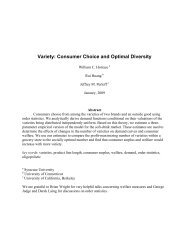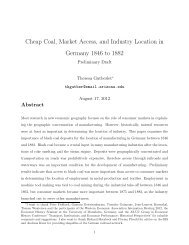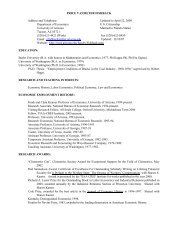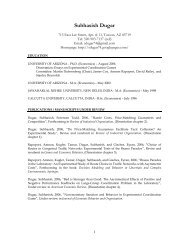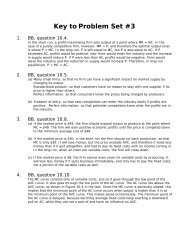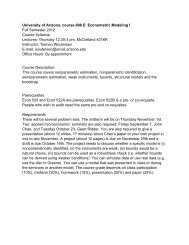A Dynamic Model of Demand for Houses and Neighborhoods
A Dynamic Model of Demand for Houses and Neighborhoods
A Dynamic Model of Demand for Houses and Neighborhoods
Create successful ePaper yourself
Turn your PDF publications into a flip-book with our unique Google optimized e-Paper software.
<strong>of</strong> $114,368.<br />
Table 7: Willingness to Pay <strong>for</strong> 10% increase in Amenities<br />
MW T P<br />
%white $1076.56<br />
violent crime rate -$655.99<br />
ozone -$155.58<br />
6 <strong>Dynamic</strong> versus Static Approaches<br />
Equation (8) illustrates the problems associated with estimating a static model when the true<br />
model is dynamic. Specifying a static model creates an omitted variables problem. Current<br />
neighborhood characteristics determine the choice specific value functions in two ways: they<br />
affect the flow utility directly <strong>and</strong> they help predict future neighborhood utility. Estimating a<br />
static model omits the second effect.<br />
The nature <strong>of</strong> how current characteristics predict future utility will determine whether the<br />
static estimator over-predicts or under-predicts the effect <strong>of</strong> the characteristic on utility. For<br />
example, if high pollution today predicts falling pollution tomorrow, then we would expect the<br />
static model to understate the disutility <strong>of</strong> pollution. This is, in fact, the pattern we see over<br />
time in our data describing both ground-level ozone <strong>and</strong> violent crime. The argument is simple<br />
– households may be willing to pay quite a bit to avoid high levels <strong>of</strong> air pollution or crime.<br />
However, when they see a neighborhood with low values <strong>of</strong> one <strong>of</strong> these disamenities, they know<br />
that value will rise in the future; they are there<strong>for</strong>e less willing to pay as much <strong>for</strong> a house in<br />
that neighborhood as they would be if the low value were permanent. Transitory amenities<br />
are simply not worth as much. A naive hedonic model ignores this fact <strong>and</strong> takes households’<br />
behavior as evidence that the low values <strong>of</strong> the disamenity aren’t actually worth that much.<br />
In contrast, there are other neighborhood attributes that are persistent over time (e.g., racial<br />
composition). In contrast to ozone <strong>and</strong> crime, seeing a high value <strong>of</strong> “percentage white” today<br />
signals that the neighborhood is likely to remain high percentage white in the future. If this<br />
is an attribute that households value (recall that we are only modeling the decisions <strong>of</strong> white<br />
28



